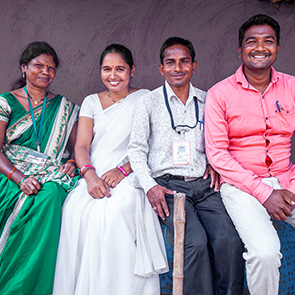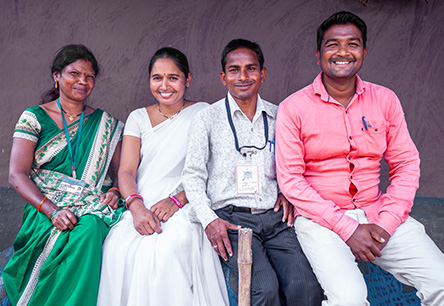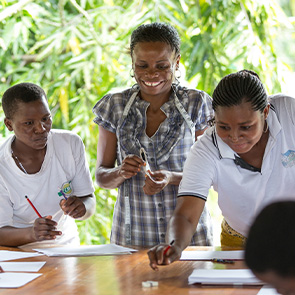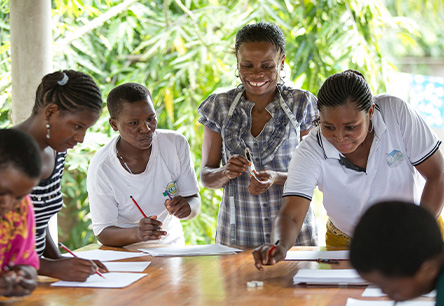According to the World Health Organization, sight is the most dominant of the five senses and plays a crucial role in every facet of our lives. But unmet needs in eye health continue to affect people the world over and especially the most vulnerable and under-resourced populations.
Worldwide, more than 2.2 billion people are visually impaired, and more than 1 billion are forced to live with preventable or treatable conditions because they cannot get the care they need.19 At Johnson & Johnson Vision, part of J&J MedTech, we have a bold ambition to change the trajectory of eye health worldwide. We deliver innovation that enables eye care professionals to create better outcomes for patients throughout their lives, and we collaborate to expand access to quality eye care in communities with the greatest need.
Peter Menziuso
Company Group Chairman, Johnson & Johnson Vision
Improving vision in a digital world
With adults spending 35% more time on digital devices in a post-pandemic world—13 or more hours per day according to estimates20—the strain on eye health is noticeable. With eyes locked on a screen for long periods, people blink less; this has a destabilizing effect on the tear film, causing dryness and discomfort. Following feedback from eye care professionals and patients we’ve worked to help meet the needs of digitally intensive lifestyles through increased education and the launch of a new contact lens ACUVUE OASYS MAX 1-DAY to help reduce light scatter and block UVA and UVB rays.
Cataracts are one of the leading causes of preventable blindness worldwide, impacting almost 100 million people globally.21
Seeing better in low-light conditions
Presbyopia, in simple terms, is an age-related condition that reduces the ability of near vision, projected to affect 2.1 billion people globally in 2030.22 To provide relief for the many people whose quality of life is reduced by presbyopia, Johnson & Johnson Vision introduced our next-generation presbyopia-correcting intraocular lens (PC-IOL) TECNIS SYMFONY OPTIBLUE IOL in the U.S. and select countries in EMEA in 2022. Using this high-performance technology, eye care professionals can offer patients a full range of high-quality continuous vision in all lighting conditions.
Half of the world’s population is projected to be myopic by 2050 with nearly one billion people expected to have high myopia.23
Advancing eye health digital innovation in Asia Pacific
In 2022, Johnson & Johnson Vision signed a Memorandum of Understanding with the Agency for Science, Technology and Research (A*STAR) to jointly establish an Eye Health Digital Innovation Consortium in Singapore. Hosted at A*STAR’s Institute of High Performance Computing, the consortium focuses on advancing eye health research in the Asia Pacific region. A joint investment of SGD 15 million from both organizations will be channeled into the consortium over the course of three years. As the first of its kind in the region, the consortium will initially focus on the following:
- improving eye healthcare delivery from eye care professionals to patients in Singapore and beyond;
- optimizing collaboration between the private and public sector to enhance eye healthcare delivery; and
- developing new technological processes to support enterprises that are directly involved in primary eye healthcare delivery.
The prevalence of distance vision impairment in low- and middle-income regions is estimated to be four times higher than in high-income regions.24
Professor Tan Sze Wee
Assistant Chief Executive, Enterprise, A*STAR
Slowing myopia progression in children
Myopia, sometimes called nearsightedness, is a chronic and progressive disease that can lead to sight-threatening complications over time. Children under 12 who are diagnosed with myopia are at a greater risk of developing high myopia in later life. Among the first in the industry to recognize the importance of myopia management, following decades of research to develop scientifically proven solutions, Johnson & Johnson Vision launched ACUVUE ABILITI to address the prevalence and progression of myopia in children. ABILITI is designed to fit seamlessly into the lifestyle of parents and children.
In 2022, we launched ABILITI 1-DAY and ABILITI OVERNIGHT in Canada, Hong Kong and Singapore. We also received FDA approval of lens parameter expansion for ABILITI OVERNIGHT to extend the reach for patients in the U.S. With these developments, more patients in more parts of the world can now enjoy better vision throughout their lifetimes.
Bringing critical eye care to children
Sight for Kids (SFK) was founded in 2002 by Johnson & Johnson Vision and Lions Clubs International Foundation and has administered free, volunteer-directed vision screenings to more than 42 million children in five countries, including India, Kenya, the Philippines, Thailand and the U.S. Today, as SFK celebrates 20 years of bringing critical eye care to children in under-resourced communities, it is the largest-known program of its kind in the world.
In 2022, in the U.S., SFK expanded beyond the South Florida region to a second location by teaming up with the Louisiana Lions Eye Foundation to provide free statewide eye care to Louisiana’s youth. A vision screening event and tours of the mobile screening unit marked this new activity.

Dr. Freddy T. Simon
Ophthalmologist, Kerala, India
Prioritizing eyes in South America
Johnson & Johnson Vision led a meaningful campaign in 2022 to advance access to eye care for people living in remote areas of several countries, including Argentina, Brazil, Chile, Colombia and Mexico. We led awareness campaigns using different media channels to raise awareness and worked closely with nonprofits throughout the region to encourage people to show up for eye tests and receive any necessary treatment.
people reached
eye examinations
eye surgeries
Celebrating World Sight Day 2022
Johnson & Johnson Vision selected World Sight Day to share its Vision for Good 2021 Impact Review, with additional examples of how we are helping change the trajectory of eye health while operating in an environmentally sustainable manner.
19WHO, “World report on vision,” https://www.who.int/publications/i/item/9789241516570, accessed February 2023.
20COVID-19: Screen Time spikes to more than 13 hours per day according to Eyesafe Nielsen estimates, published 3/28/20, https://eyesafe.com/covid-19-screen-time-spike-to-over-13-hours-per-day, accessed February 2023.
21WHO, “Blindness and vision impairment,” https://www.who.int/en/news-room/fact-sheets/detail/blindness-andvisual-impairment, accessed February 2023.
22Grzybowski, A and Ruamviboonsuk, V, “Pharmacological Treatment in Presbyopia,” J. Clin. Med. 2022, 11(5), 1385, https://doi.org/10.3390/jcm11051385, accessed February 2023.
23WHO, “World report on vision,” https://www.who.int/publications/i/item/9789241516570, accessed February 2023.
24WHO, “Blindness and vision impairment,” https://www.who.int/en/news-room/fact-sheets/detail/blindness-andvisual-impairment, accessed February 2023.








